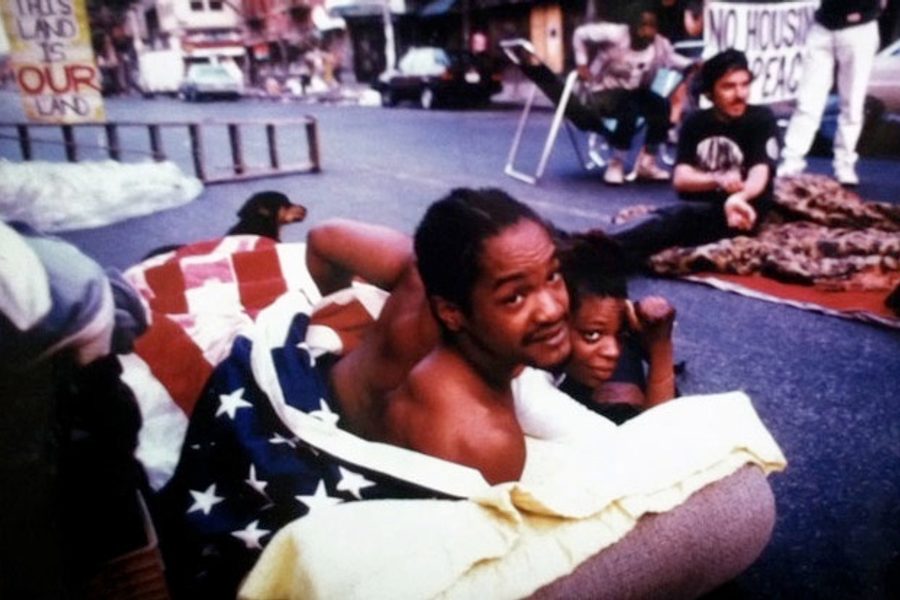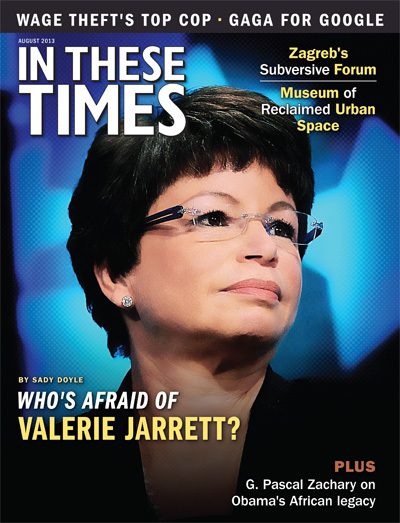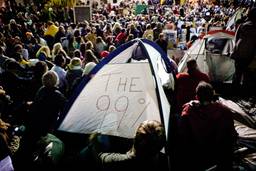A Brief History of Squatting
The Museum of Reclaimed Urban Space chronicles decades of Lower East Side occupations.
Arun Gupta

He had warned me about showing up unannounced, but it’s easy to rationalize such things when you’re jonesing. It was 1999. I stood outside the Lower East Side squat bellowing, “Laaaarr-rreeee.” Making myself a nuisance earned me admission into the building, though the squatters clustered out front looked at me with expressions that read: “Who is this idiot?”
Larry was livid when I stepped into his apartment. “Don’t ever fucking do that again!” he roared. But in an instant his eyes were smiling and he sweetly inquired, “Now, how may I help you?”
Chagrined, I conducted my business and exited. Striding past the German beer garden, I mentally savored my spliff while lamenting the disappearance of the storefront dealers who peddled dime bags with the convenience of a 7-Eleven. That’s routine for denizens of the Lower East Side: to wistfully recall what once was.
Before Rudy Giuliani became mayor in 1994, the neighborhood was alluringly feral. The withdrawal of public services, crime epidemic and abandonment of housing decades earlier had spawned a multiracial movement of neighborhood associations, building takeovers, community gardens and thriving institutions such as the Nuyorican Poets Cafe, the punk-centric ABC No Rio and the housing-rights organization Good Old Lower East Side.
No one misses the muggers, street dealers hawking smack, or addicts openly sticking needles in their arms. Social pathologies were the last line of defense against capital, until Giuliani used his “quality of life” campaign against the homeless, potsmokers, bicyclists and the poor to also sweep away Bohemia.
The transformation from heroin shooters to oyster shooters is now complete, but the past still pokes through the present landscape of faux speakeasies, fin-de-siècle bistros and bucolic gastronomica.
The Museum of Reclaimed Urban Space (MoRUS), located in a storefront of C-Squat, is one of 11 surviving squats that have made peace with the city. The mini museum, a tribute to local activism, contains a photographic journey through decades of squatting, gardens, Critical Mass, Reclaim the Streets and Occupy Wall Street. Co-founder Bill DiPaolo calls it “living history,” and it faithfully evokes decades of resistance to a hidden market and its visible fist.
The tone is set by one of the first photos, an image of an armored police vehicle with tank treads deployed to evict two squats in 1995. As the photos progress, a changing cast faces off against the police: homeless people living in Tompkins Square Park in the early ’80s, their expressions defiant or pleading; the street punks and squatters of the late ’80s; Reclaim the Streets’ impromptu dance-party protests and community garden defense in the ’90s.
Artifacts are grouped thematically. An egg carton of seed bombs ($12 a dozen), designed to be thrown into fenced-off vacant lots for guerrilla greening, ac- companies photos of the campaign that saved scores of gardens from Giuliani’s bulldozers. The stairway chronicles the history of Critical Mass, which popularized bicycling in New York City by drawing thousands of pedal-pushers into the streets for monthly rides before being smashed by the cops in 2004. The banister is built from wooden blue police barricades that were a fixture in the neighborhood until the mid-’90s and the fuel for riotous bonfires. The Occupy Wall Street section features a sign liberated from Zuccotti Park listing activities now banned — skateboarding, camping and lying down. Helmets and dark-blue uniforms emblazoned with “Squat Team” patches hang in the front window.
The focus, says DiPaolo, is “groups, causes, spaces and places,” not art or individuals. But the most captivating images are of art and people: Gardening pioneer Adam Purple standing above his “Garden of Eden” of trees and edible plants arrayed in concentric circles around a blooming yin-yang symbol; a half-dressed black couple on Avenue A lying on a futon under an American flag; an abandoned car plastered with graffiti in a vacant lot carpeted with foliage.
Even allowing for the museum’s space constraints, there are curious omissions. Housing was the central struggle, but there is little explanation of how bankers and landlords used finance and zoning to initiate disinvestment, then gentrification. The museum selects the Green Guerrillas in 1978 as the starting point, and, aside from a section honoring the work of Chino Garcia and Armando Perez, excludes the Puerto Rican activists of the ’60s and ’70s who staged the first building takeovers and created gardens, tenants associations, an arts revival, and community and environmental organizations. Some of that is covered in MoRUS’s guided tours of the neighborhood, but the exhibit appears to reflect DiPaolo’s own history. He is the founder and director of Time’s Up!, “a direct action environmental organization” that spawned Critical Mass, participated in Reclaim the Streets and Occupy Wall Street, and engaged in nonviolent direct action that preserved the gardens. (DiPaolo also homesteads in Umbrella Squat down the block.)
Try though it may to present a picture of protest springing eternal, the museum reveals the shifting dynamics of the Lower East Side. As the photos tick off the years, the people become whiter, the reclaimed spaces narrow from houses to gardens, from street occupations to sidewalk protests, and the protesters grow older and middle class. In the end, the visionaries who proclaimed, “We will build a new society in the vacant lots of the old,” defend fragile stands of bohemia by adapting to the invasive monoculture of condos, clubs and cafes. MoRUS pays $2,000 in rent, a token sum compared to the $15,000-to-$20,000 payment a landlord is demanding of the nearby Yippie Café.
Unfortunately, MoRUS glosses over daily life. Lawless creativity and politics attracted youth fleeing a consumer society for a hotbed of radical writers, artists, musicians and poets, studios and playhouses, punk shows and underground newspapers, squat parties and park festivals. This political culture nurtured space for everyday wonders that have been stomped out: from all-night gatherings in gardens to youth launching cannonball-sized fireworks in a Chinatown schoolyard to locals making carrion of abandoned cars, taking months to strip them of salable parts.
But real-estate speculators sealed the Lower East Side’s fate by pouncing on the marketing potential of its distinctive culture. Then again, efforts to preserve the uniqueness were undercut by those punks and anarchists who opposed efforts to tame excesses because that’s “fucking authoritarian, man,” enabling loudmouths, slackers and self-destructive drug use to alienate potential allies in local communities and movements.
The Museum of Reclaimed Urban Space captures the duality of a movement that saw its struggle as the only struggle, limiting its vision and audience — yet against all odds it triumphantly managed to scratch out reclaimed space in the heart of the 1%.








